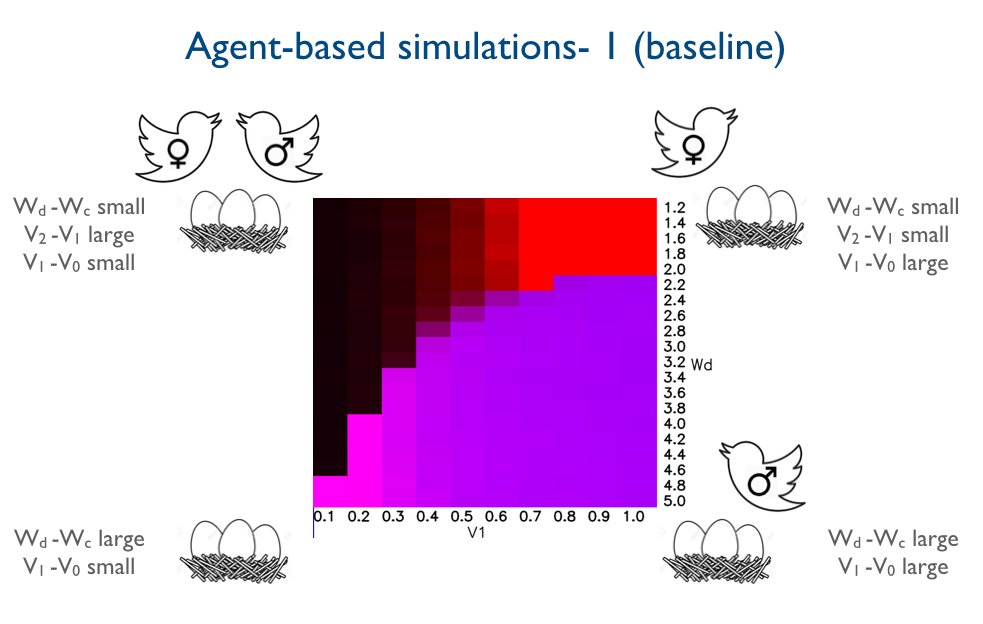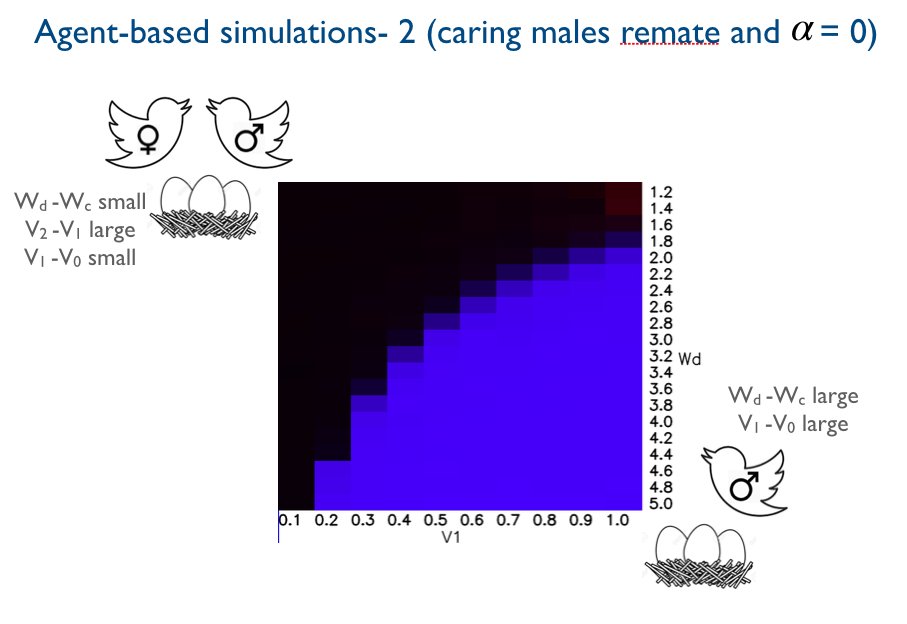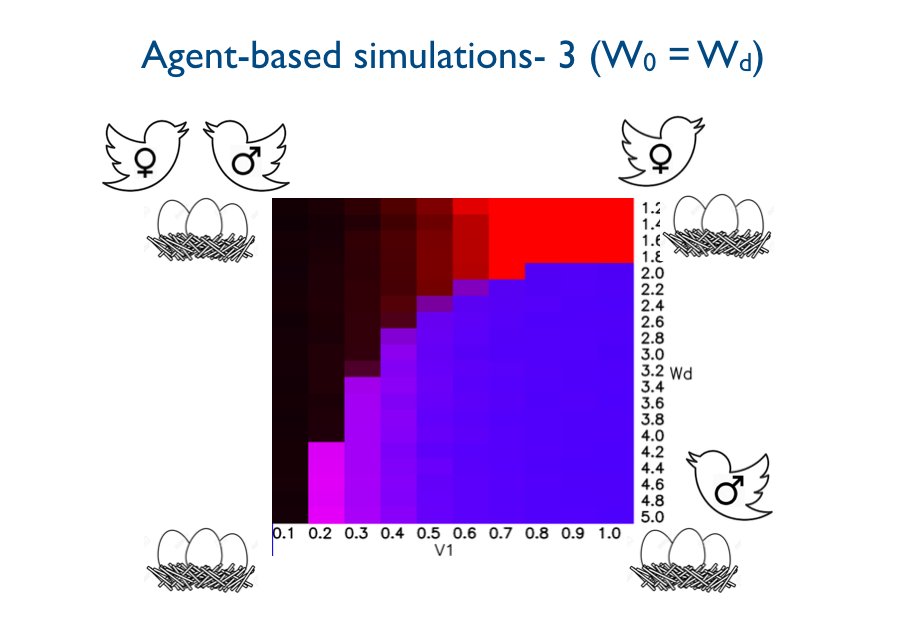Here’s a 36-tweet long summary of our paper that’s coming out in Evolution. This is work done with Abhishek Shukla, @19Vivekj and @BikashSahoo360. We were hosted and supported by the really wonderful TEE lab at CES, IISc headed by @vishuguttal.
Link to the paper: https://onlinelibrary.wiley.com/doi/10.1111/evo.13969">https://onlinelibrary.wiley.com/doi/10.11...
We see a variety of sex roles in parental care across animal taxa. In a large number of fish, reptiles, amphibians and invertebrates, no parental care is provided beyond the investment in gametes. 2/36
In the majority of fish species with parental care, only the males provide care. More than 90% of birds have biparental care. And in about 90% of mammals, only the females provide care. 3/36
Despite this diversity, females care more than males in a majority of species. Our paper questions one influential hypothesis that was proposed to explain this pattern. 4/36
The parental investment hypothesis proposed by Trivers in 1972 attributes this pattern to the distinction defining the sexes, which is anisogamy. This is the difference in gamete sizes that males and females produce. 5/36
Trivers made two arguments, later dubbed as the ‘female’ and ‘male’ arguments. The ‘female’ argument says that because the initial investment by females in the eggs is higher, they have more to lose if the offspring does not survive, and hence they care more.
The ‘male’ argument says that male-male competition tends to operate against male parental investment, because any male investment in one female’s young decreases the male’s chances of inseminating other females. 7/36
Dawkins and Carlisle (1976) criticised the ‘female’ argument of committing the ‘sunk cost fallacy’. They argue that animals should be adapted to strategize based on future and not past considerations. 8/36
Maynard Smith in 1977 developed a simple game between a mated male and female to consider a prospective analysis. Each player has two strategies: to care or to desert. 9/36
Females who desert can lay more eggs. Males who desert can gain matings. On analysing this simple game, he found that each of the 4 patterns (both care, only males care, only females care, no parent cares) can be evolutionarily stable based on the parameters.
While this is great as a simple model that explains the diversity in nature, Wade and Shuster pointed out in 2002 that the model is fundamentally flawed as it is not self-consistent. That is, the total male fitness does not equate the total female fitness.
We develop multiple self-consistent versions of Maynard Smith’s model, and specifically incorporate the expected consequences (‘C’s’ below) of eggs being expensive to produce and sperm being cheap: (12/36)
C1. Egg production is limited as eggs are expensive, where as C2. the sperm production is generally not expected to be a limiting factor for male fitness, (13/36)
C3. As eggs as expensive, egg production is expected to trade-off with costly traits like parental care, where as C4. sperm production need not have this trade off. And C5. both sexes may be mate limited, but males are expected to be mate-limited more often.
We develop 3 evolutionary games that incorporate these consequences. In all the games, females who desert lay a second clutch with the extra eggs, and hence provide mating opportunities for males who desert. 15/36
In Game-1, only the deserting males can remate (due to mating-caring trade-off), but they are not limited by how many times they can remate (due to C2). The ESS are symmetric with both males and females caring equally. 16/36
In Game-2, caring males can also remate (due to C4), but deserting males have a remating advantage. The ESS now include male-only care apart from the symmetric ESS. 17/36
In Game-3, deserting females lay more eggs in the first clutch. This again selects for male-care ESS apart from symmetric ESS. Hence males care more than females in all the analytical self-consistent versions of Maynard Smith’s game we consider.
In all these analytical games, all the matings in the population are assumed to occur synchronously. We relax this assumption and model asynchronous matings with agent based simulations (ABS). In this situation, deserting males can mate with unmated females.
In the ABS corresponding to Game-1, all 4 patterns of ESS are possible based on the parameters. In the figure below, the ESS are colour coded: red for female-only care, blue for male-only care, black for biparental care and magenta for biparental desertion.
Female-only care is selected when the number of extra eggs (Wd-Wc) is small, and the benefit of uniparental care (V1-V0) is large. Biparental care is selected when the benefit of both parents caring (V2-V1) is large. 21/36
Both parents desert when the number of extra eggs is large and the benefit of uniparental care is small. Male-biased care is selected when the number of extra eggs is large and the benefit of uniparental care is also large. 22/36
In the ABS corresponding to Game 2 (when caring males can also remate), the ESS are either biparental care or male-only care. As the mating advantage for deserting males decreases, the ESS change continuously from those for ABS-1 to ABS-2. 23/36
We see in the ABS corresponding to Game-3 as well that there is more blue than for ABS-1, hence more male-only care ESS. Hence the ABS corroborate the results from the analytical games, although they allow for female-only care ESS.
One reason that we differ from the verbal models like Trivers’ is frequency-dependent selection that acts in self-consistent models. As the frequency of males deserting increases, there is greater competition among males for mating, and the payoff to desertion decreases.
This, along with the coevolution of male and female strategies in all our models, selects for male-biased care ESS. 26/36
Another outcome is higher the degree of synchrony of matings, more likely are the ESS to be male-biased care. Asynchrony of matings provides more mating opportunities for males, and hence selects for greater male desertion overall. 27/36
We argue that our models refute the generality of Trivers’ parental investment hypothesis. The analytical models incorporate various consequences of eggs being expensive and sperm cheap to produce, but the only asymmetric ESS are male-care ones.
In the ABS, female-care ESS are possible for some parameters, but male-care ESS are selected for other parameters. Hence we find no evidence for a causal link between anisogamy and female-care ESS. Hence the ‘female’ argument certainly does not work. 29/36
Regarding the ‘male’ argument, we incorporate the mating-caring trade-off for males in many of our models. And that still results in male-care ESS. Moreover, we argue that this trade-off could be weaker for males than females due to anisogamy.
However, we haven’t considered the co-evolution of costly traits for male-male competition along with parental care. This co-evolution could result in female-care ESS, as shown by Fromhage and Jennions, 2016. 31/36
We also do not consider biased sex ratios, sexual selection or partial parentage. These factors can also bias the sex roles in parental care. Some of these are subjects of our forthcoming studies. 32/36
Two mechanisms that result from anisogamy select for male-care in out models: weaker trade-off between mating and caring for males, and the possibility of deserting females laying larger first clutches. Male-care in fish and birds have been attributed to these mechanisms.
Interestingly, many studies have suggested that the ancestral transitions in both fish and bird clades may have been from no parental care to paternal care. Mechanisms we propose for male-care ESS could be responsible for some of these transitions. 34/36
To conclude, we refute the causal link between anisogamy and female-care ESS. We suggest that the ways in which anisogamy leads to sex-specific selection, including different relationships between mating and caring, needs to be better understood.
Moreover, aspects of the mating systems, such as temporal synchrony and spatial clustering may help explain the diversity of sex roles in parental care and competitiveness. 36/36

 Read on Twitter
Read on Twitter




